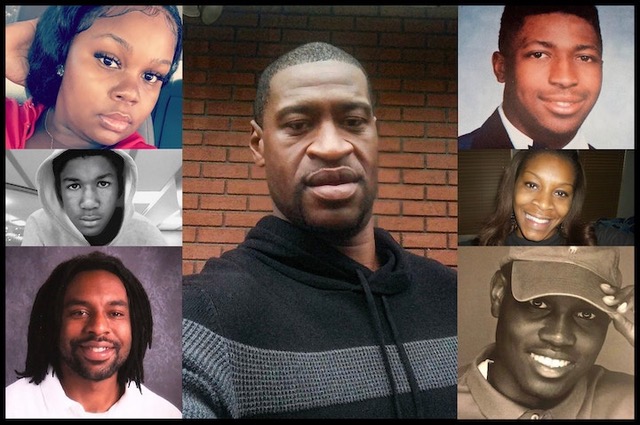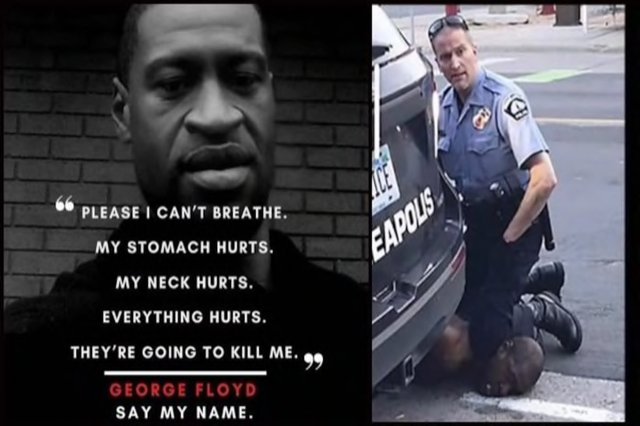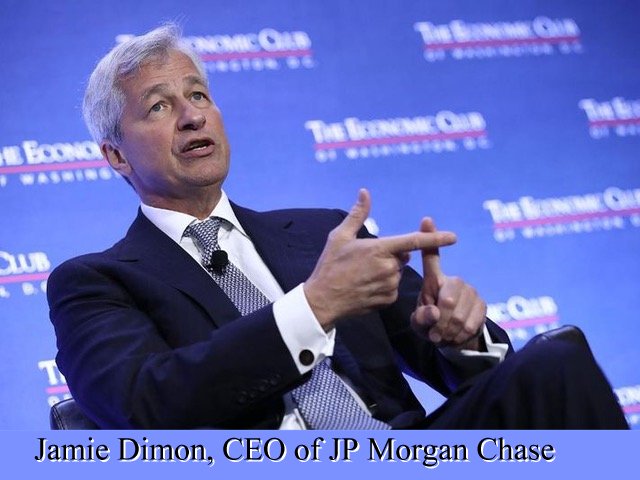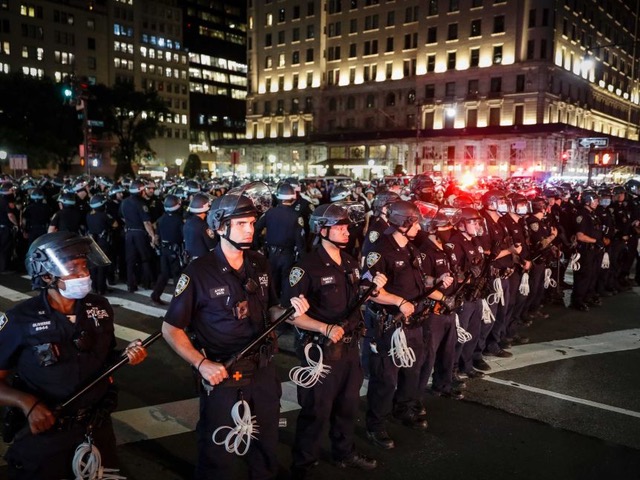“That’s not a chip on my shoulder, that’s your foot on my neck” (Malcolm X, 1964)

U.S. cops have been choking the life out of Black men for over a hundred years. In the nineteenth and well into the twentieth century, black men were lynched. Today they are murdered by police-applied chokeholds. This level of state-sanctioned violence is not surprising considering that domestic law enforcement evolved from slave patrols organized by wealthy slave owners and sanctioned by local authorities to catch (and kill) runaway slaves — “Slave patrols and Night Watches, which later became modern police departments, were both designed to control the behaviors of minorities.” (“A Brief History of Slavery and the Origins of American Policing,” Victor E. Kappeler)
In the last few decades, police have added a new wrinkle —preemptive policing in minority neighborhoods targeting Black and Hispanic young men who haven’t committed crimes but who police suspect might. All it takes is a young black man walking in a white neighborhood.
African American men face other hazards on the streets. An encounter with a cop with prior military training (twenty percent of U.S, police have a military background) can quickly become lethal particularly as America’s perpetual wars are usually fought in majority non-white countries. Derek Chauvin the cop who murdered George Floyd had been a military policeman from 1996-2000. Even before he became a police officer and had a license to use deadly force, Chauvin was aggressive particularly when dealing with the Black community. The owner of a bar where he was a security guard remembered “His face, attitude, posture would change when we did urban nights…” (to celebrate local Black communities)
He had also been accused eighteen times of misconduct and excessive force in his nineteen-year police career. Only two of the complaints were deemed worthy of even a mild rebuke.
Police misconduct against minorities including murder have gone unpunished either from the reluctance of state and federal prosecutors to charge them or the unwillingness of juries to convict them. In 2014, grand juries declined to indict the cops who killed Eric Garner in Staten Island, Michael Brown in Fergusson Missouri and Tamir Rice (12 years old) in Cleveland. All the victims were African Americans, None had a history of violence. Yet they all died at the hands of white policemen. In 2015, both federal and state law enforcement agencies refused to charge the cops who killed Alton Sterling in Baton Rouge. That same year, Freddie Gray, a black man, died from injuries he sustained being transported to jail. Six officers who failed to secure him in the van were indicted for murder, manslaughter and assault. They were acquitted. The U.S. Justice Department failed to bring federal charges. A year later, in 2016, the cop who murdered Philando Castile in Minnesota was acquitted by a jury. In the case of seventeen-year-old Laquan McDonald who in 2018 was shot sixteen times, the jury convicted the cop of second, not first degree murder. He was sentenced to less than seven years.

Everything changed in 2020, when two black men and one black woman were murdered by the police. On May 25 when George Floyd was murdered, bystander video recording his agonizing death — “Please, please, please, I can’t breathe. My stomach hurts. My neck hurts. Please, please. I can’t breathe.” — was viewed by hundreds of millions around the world. Soon protests and demonstrations brought thousands of people, both black and white, into the streets even in the face of the pandemic. it wasn’t long before demonstrations occurred all over the world. Two weeks later another black man, Rayshard Brooks, was shot in the back by a white policeman. The March 13th murder of Breonna Taylor as she slept in her apartment gained heightened visibility as protests in the streets mounted.

Large corporations, particularly in the financial sector quickly got the message. Following the age-old maxim that talk is cheap but a hit to the bottom line can be a death sentence, corporations, particularly the banks, quickly became penitent. Here’s Jamie Dimon, CEO of J.P. Morgan Chase (annual pay $31.5 million in 2019)— “we are watching, listening and want every single one of you to know we are committed to fighting against racism and discrimination wherever and however it exists.” Depends on what you mean by fighting. Not long ago a government lawsuit cost Dimon’s bank $55 million to settle claims of Chase’s discriminatory lending practice “[which] has been intentional and willful, and has been implemented with reckless disregard of the rights of African-American and Hispanic borrowers.” (U.S. government lawsuit)
Not to be outdone, Bank of America CEO Brian Moynihan uncorked this whopper (annual pay $26.5 million in 2019) — I have listened and learned from all of you, from our communities and, for the last ten years, from my colleagues on the board of the National Museum of African American History and Culture.” Really? Among a multiplicity of discriminatory lending practices, BOA has “intentionally failed to provide routine exterior maintenance … in working- and middle-class African American and Latino neighborhoods in 37 metropolitan areas, while they consistently maintained similar bank-owned homes in comparable white neighborhoods.” (National Fair Housing Alliance lawsuit)
How real is corporate America’s new-found commitment to the desperate needs of America’s working class? Pre-COVID, the majority of Americans (58%) had less than $1,000 in savings (2019) and 78% of U.S. workers lived paycheck to paycheck. As the pandemic closed down the U.S. economy, the disparity in who lost their jobs was another blow to minority households. 40% of the lowest-earning Americans lost their jobs while among the highest earning Americans only 9% suffered the same fate. (Federal Reserve) Corporations talk a good game but at the first sign of falling profits, the axe starts falling — on the lowest paid and most vulnerable workers.
How did U.S. oligarchs fare as a result of the pandemic? Would it surprise you to learn that they hauled away an extra $434 billion as COVID-19 raged? The richest man in the world and possibly the sleaziest, Jeff Bezos, hauled away $30 billion.
George Floyd’s death was the spark that ignited a nationwide conflagration. This is not the first year in which Black men and women have been victims of police violence. Regardless, the police have always been able to control the protests that erupted. This time it was different, Americans responded to the pent-up fury and frustration of losing their jobs and their health insurance, being unable to pay their rent or their student loans, of having to shelter in place for three months, stand by helplessly as loved ones sickened and died and see the senseless murders of innocent men and women by making for the streets. Compounding their distress was the spectacle of the richest Americans lounging in their mansions and gated communities.

This reality — working Americans trapped in an economic Armageddon — is a bipartisan failure of leadership. This is not the first time. It happened before, only the cast of characters was different. In 2008, in the midst of an economic meltdown, the ruling class led by Barack Obama bailed out the perpetrators— the wealthy banks. The public was left floundering in a sea of debts, evictions and foreclosures. Come 2020 the same rich bankers and corporate honchos are occupying all the seats on the federal life raft with $4 trillion in virtually free money, billion dollar subsidies and tax cuts.
A combination of factors, economic, social, even political (dashed hopes of millions after Bernie’s betrayal) gave life to this movement. The deaths of two black men and one black woman energized it with hope and purpose. The usual blandishments of the Democratic machine —that voting not demonstrating is the answer— fell on deaf ears. Adding to their hypocrisy was the Democrats’ choice to run against Trump. Joe Biden, the architect of both the 1994 crime bill that made the U.S. the world’s leading carceral nation and the 1995 bankruptcy law that has made it virtually impossible for millions of students (45 million and rising) and thousands of poor people to discharge their debts in bankruptcy and whose response to cries for a national healthcare system “How are we going to pay for it” will change nothing but replace the hard-edged Trump with a kinder, gentler face of the same repression.“ it’s not the voting booth we should be heading for in 2020 but the streets.
31,422 total views, 4 views today
